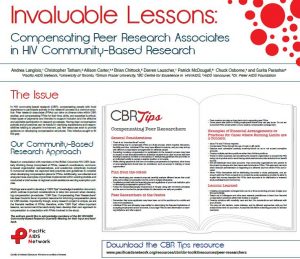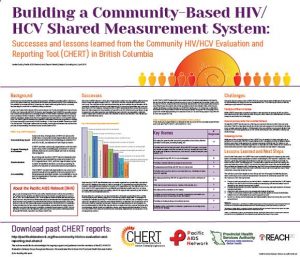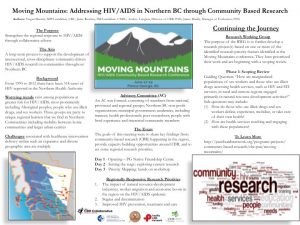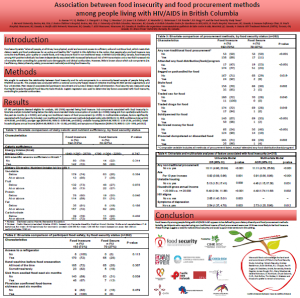Welcome to the Pacific AIDS Network’s spring review of What’s HOT in HIV Research! In this edition we are going to take a look at contributions made by the PAN team to the Canadian Association for HIV Research (CAHR) 2015 Conference in Toronto, which was held in April.
This poster, presented by PAN and members of a BC working group made up of members from our HIV CBR in BC Quarterly meetings, highlighted key learnings around thoughtful compensation of peer research associates in HIV community based research (CBR).
In HIV-related CBR, compensating people with lived experience to particip ate actively in the research process is a common practice. Peer research associates (PRAs) can take on diverse roles within CBR studies, and compensating PRAs for their time, skills, and expertise is critical; these types of payments are intended to support inclusion and the effective and equitable participation in research processes.
ate actively in the research process is a common practice. Peer research associates (PRAs) can take on diverse roles within CBR studies, and compensating PRAs for their time, skills, and expertise is critical; these types of payments are intended to support inclusion and the effective and equitable participation in research processes.
Having clear compensation policies and procedures can be helpful in clarifying expectations and responsibilities relating to people’s involvement, yet, few resources exist to provide guidance on developing compensation structures. This initiative sought to fill this gap, and our poster at CAHR highlighted tips from our CBR Tips resource on this topic.
What’s been learned from the process of developing BC’s CHERT? CHERT is an online survey that collects annual data from community-based organizations (C BOs) with the goal of demonstrating the collective contribution made by community programs.
BOs) with the goal of demonstrating the collective contribution made by community programs.
This poster presents some of the challenges and lessons learned from this effort to develop a shared measurement system, including how it’s important to focus on outcome indicators as well as process indicators and how data collection can be challenging for CBO staff, who have limited resources available for this task. Moving forward, the importance of having a strong central leadership and implementation team and aligning the tool with relevant policy documents and strategies will be an important factor in success.
In 2014, PAN partnered with researchers from the University of Northern British Columbia and community organizations to co-host a process aimed at generating HIV CBR research priorities for BC’s Northern region, as well as sharing findings from local studies and building capacity to participate in CBR.
CBR research priorities for BC’s Northern region, as well as sharing findings from local studies and building capacity to participate in CBR.
This poster presents information about the process and its findings, which noted that there are several pressing topics for HIV CBR, including the need to examine the impact of natural resource development industries and economic boom on the HIV/AIDS epidemic. A more detailed account of this initiative is available in a recently published article in the Canadian Journal of Aboriginal HIV/AIDS Research.
- Findings from the Impacts of Food Security on Health Outcomes in People living with HIV/AIDS in BC study
Two posters from this HIV/AIDS and food security study were presented at CAHR, one that focused on the experiences of peer research associates in the study, and a second that outlined the association between food insecurity and food procurement methods.
Peer Research Associates’ Experience: This poster spoke to the challenges and key learnings regarding the role of peer research associates (PRAs ) in this CBR study, which was the first national HIV CBR study to engage PRAs. The study had many successes including: building strong capacity in a team of PRAs and shifting the community’s perception of the value of research. One major challenge was with PRAs’ isolation given the large geographic area covered.
) in this CBR study, which was the first national HIV CBR study to engage PRAs. The study had many successes including: building strong capacity in a team of PRAs and shifting the community’s perception of the value of research. One major challenge was with PRAs’ isolation given the large geographic area covered.
The team learned many things, including the importance of: engaging PRAs at the beginning of the research process and building a strong and ongoing communication structure between all team members. This study provided the PRAs opportunities to learn new skills interact with their peers in different ways, cross education and de-stigmatization as well as opened up new career opportunities. The lessons collectively learned have informed other CBR projects and the study results have been used to develop two new food programs in the province.
Association between Food Insecurity and Food Procurement Methods among People Living with HIV/AIDS in BC: Studies suggest that people living with HIV/AIDS in high-income settings suffer high levels of food insecurity. However, limited evidence exists regarding the dietary intake of this population and  sub-components driving food insecurity (i.e. food quantity, quality, safety or procurement). This poster presents an examination of the prevalence and characteristics of food insecurity among HIV-positive people across BC, looking specifically at the association between food insecurity and food procurement methods.
sub-components driving food insecurity (i.e. food quantity, quality, safety or procurement). This poster presents an examination of the prevalence and characteristics of food insecurity among HIV-positive people across BC, looking specifically at the association between food insecurity and food procurement methods.
Food insecurity amongst participants in this study appears to be defined by poor dietary diversity and food procurement methods. Notably, participants who reported using non-traditional means of food procurement (such as trading sex or drugs for food or procuring food from dumpsters) were over 10 times more likely to be food insecure. These findings suggest a need for tailored food security and social support interventions in this setting.
Questions? Feedb ack? Get in touch!
ack? Get in touch!
Andrea Langlois
Director, Community-Based Research
andrea@paninbc.ca
Twitter: @PAN_CBR
